Lymph node
| Lymph node | |
|---|---|
 Diagram showing major parts of a lymph node | |
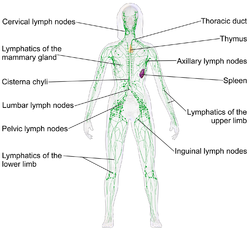 Lymph nodes form part of thelymphatic system,and are present in most parts of the body, and connected by small lymphatic vessels. | |
| Details | |
| System | Lymphatic system,part of theimmune system |
| Identifiers | |
| Latin | nodus lymphaticus (singular); nodi lymphatici (plural) |
| MeSH | D008198 |
| TA98 | A13.2.03.001 |
| TA2 | 5192 |
| FMA | 5034 |
| Anatomical terminology | |
Alymph node,orlymph gland,[1]is akidney-shapedorganof thelymphatic systemand theadaptive immune system.A large number of lymph nodes are linked throughout the body by thelymphatic vessels.They are major sites oflymphocytesthat includeBandT cells.Lymph nodes are important for the proper functioning of theimmune system,acting as filters for foreign particles includingcancer cells,but have nodetoxificationfunction.
In the lymphatic system, a lymph node is asecondary lymphoid organ.A lymph node is enclosed in a fibrous capsule and is made up of an outer cortex and an inner medulla.
Lymph nodes becomeinflamedor enlarged in various diseases, which may range from trivialthroat infectionsto life-threateningcancers.The condition of lymph nodes is very important incancer staging,which decides the treatment to be used and determines theprognosis.Lymphadenopathyrefers to glands that are enlarged or swollen. When inflamed or enlarged, lymph nodes can be firm or tender.
Structure
[edit]
Lymph nodes are kidney or oval shaped and range in size from 2 mm to 25 mm on their long axis, with an average of 15 mm.[2]
Each lymph node is surrounded by a fibrous capsule, which extends inside a lymph node to formtrabeculae.[3]The substance of a lymph node is divided into the outercortexand the innermedulla.[3]These are rich with cells.[4]Thehilumis an indent on the concave surface of the lymph node where lymphatic vessels leave and blood vessels enter and leave.[4]
Lymphenters the convex side of a lymph node through multipleafferent lymphatic vesselsand from there flows into a series of sinuses.[3]After entering the lymph node from afferent lymphatic vessels, lymph flows into a space underneath the capsule called thesubcapsular sinus,then into cortical sinuses.[3]After passing through the cortex, lymph then collects in medullary sinuses.[3]All of these sinuses drain into the efferent lymph vessels to exit the node at the hilum on the concave side.[3]
Location
[edit]Lymph nodes are present throughout the body, are more concentrated near and within the trunk, and are divided into groups.[4]There are about 450 lymph nodes in the adult.[4]Some lymph nodes can be felt when enlarged (and occasionally when not), such as theaxillary lymph nodesunder the arm, thecervical lymph nodesof the head and neck and theinguinal lymph nodesnear the groin crease. Most lymph nodes lie within the trunk adjacent to other major structures in the body - such as theparaaortic lymph nodesand thetracheobronchial lymph nodes.The lymphatic drainage patterns are different from person to person and even asymmetrical on each side of the same body.[5][6]
There are no lymph nodes in thecentral nervous system,which is separated from the body by theblood–brain barrier.Lymph from themeningeal lymphatic vesselsin the CNS drains to thedeep cervical lymph nodes.[7]
Size
[edit]| Generally | 10 mm[8][9] |
| Inguinal | 10[10]– 20 mm[11] |
| Pelvis | 10 mm for ovoid lymph nodes, 8 mm for rounded[10] |
| Neck | |
|---|---|
| Generally (non-retropharyngeal) | 10 mm[10][12] |
| Jugulodigastric lymph nodes | 11mm[10]or 15 mm[12] |
| Retropharyngeal | 8 mm[12]
|
| Mediastinum | |
| Mediastinum,generally | 10 mm[10] |
| Superior mediastinum and high paratracheal | 7mm[13] |
| Low paratracheal and subcarinal | 11 mm[13] |
| Upper abdominal | |
| Retrocrural space | 6 mm[14] |
| Paracardiac | 8 mm[14] |
| Gastrohepatic ligament | 8 mm[14] |
| Upper paraaortic region | 9 mm[14] |
| Portacaval space | 10 mm[14] |
| Porta hepatis | 7 mm[14] |
| Lower paraaortic region | 11 mm[14] |
Subdivisions
[edit]
A lymph node is divided into compartments callednodules(or lobules), each consisting of a region of cortex with combined follicle B cells, a paracortex of T cells, and a part of the nodule in the medulla.[15]The substance of a lymph node is divided into the outercortexand the innermedulla.[3]The cortex of a lymph node is the outer portion of the node, underneath the capsule and the subcapsular sinus.[15]It has an outer part and a deeper part known as theparacortex.[15]The outer cortex consists of groups of mainly inactivated B cells called follicles.[4]When activated, these may develop into what is called agerminal centre.[4]The deeper paracortex mainly consists of theT cells.[4]Here the T-cells mainly interact withdendritic cells,and the reticular network is dense.[16]
The medulla contains large blood vessels, sinuses and medullary cords that contain antibody-secreting plasma cells. There are fewer cells in the medulla.[4]
Themedullary cordsare cords of lymphatic tissue, and includeplasma cells,macrophages, and B cells.
Cells
[edit]In the lymphatic system a lymph node is asecondary lymphoid organ.[4]Lymph nodes containlymphocytes,a type ofwhite blood cell,and are primarily made up ofB cellsandT cells.[4]B cells are mainly found in the outer cortex where they are clustered together asfollicular B cellsin lymphoid follicles, and T cells anddendritic cellsare mainly found in theparacortex.[17]
There are fewer cells in the medulla than the cortex.[4]The medulla contains plasma cells, as well asmacrophageswhich are present within the medullary sinuses.[17]
As part of the reticular network, there arefollicular dendritic cellsin the B cell follicle andfibroblasticreticular cellsin the T cell cortex. The reticular network provides structural support and a surface for adhesion of the dendritic cells, macrophages and lymphocytes. It also allows exchange of material with blood through thehigh endothelial venulesand provides the growth and regulatory factors necessary for activation and maturation of immune cells.[18]
Lymph flow
[edit]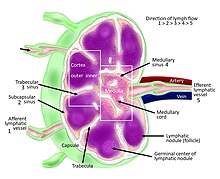
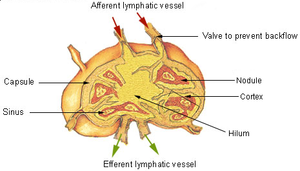
Lymph enters the convex side of a lymph node through multiple afferent lymphatic vessels, which form a network of lymphatic vessels (Latin:plexus) and from here flows into a space (Latin:sinus) underneath the capsule called the subcapsular sinus.[4][3]From here, lymph flows into sinuses within the cortex.[3]After passing through the cortex, lymph then collects in medullary sinuses.[3]All of these sinuses drain into theefferent lymphatic vesselsto exit the node at the hilum on the concave side.[3]
These are channels within the node lined by endothelial cells along with fibroblastic reticular cells, allowing for the smooth flow of lymph. The endothelium of the subcapsular sinus is continuous with that of the afferent lymph vessel and also with that of the similar sinuses flanking the trabeculae and within the cortex. These vessels are smaller and do not allow the passage of macrophages so that they remain contained to function within a lymph node. In the course of the lymph, lymphocytes may be activated as part of theadaptive immune response.
There is usually only one efferent vessel though sometimes there may be two.[19]Medullary sinuses containhistiocytes(immobile macrophages) and reticular cells.
A lymph node contains lymphoid tissue, i.e., a meshwork or fibers calledreticulumwith white blood cells enmeshed in it. The regions where there are few cells within the meshwork are known aslymph sinus.It is lined by reticular cells,fibroblastsand fixed macrophages.[20]
Capsule
[edit]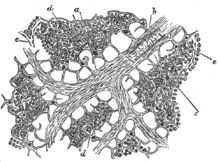
Thinreticular fibers(reticulin) ofreticular connective tissueform a supporting meshwork inside the node.[4] The lymph node capsule is composed ofdense irregular connective tissuewith some plaincollagenous fibers,and a number of membranous processes or trabeculae extend from its internal surface. The trabeculae pass inward, radiating toward the center of the node, for about one-third or one-fourth of the space between the circumference and the center of the node. In some animals they are sufficiently well-marked to divide the peripheral or cortical portion of the node into a number of compartments (nodules), but in humans this arrangement is not obvious. The larger trabeculae springing from the capsule break up into finer bands, and these interlace to form a mesh-work in the central or medullary portion of the node. These trabecular spaces formed by the interlacing trabeculae contain the proper lymph node substance or lymphoid tissue. The node pulp does not, however, completely fill the spaces, but leaves between its outer margin and the enclosing trabeculae a channel or space of uniform width throughout. This is termed the subcapsular sinus (lymph path or lymph sinus). Running across it are a number of finer trabeculae of reticular fibers, mostly covered by ramifying cells.
Function
[edit]In the lymphatic system a lymph node is a secondary lymphoid organ.[4]
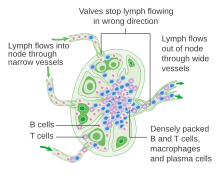
The primary function of lymph nodes is the filtering of lymph to identify and fight infection. In order to do this, lymph nodes contain lymphocytes, a type of white blood cell, which includes B cells and T cells. These circulate through the bloodstream and enter and reside in lymph nodes.[21]B cells produceantibodies.Each antibody has a single predetermined target, anantigen,that it can bind to. These circulate throughout the bloodstream and if they find this target, the antibodies bind to it and stimulate an immune response. Each B cell produces different antibodies, and this process is driven in lymph nodes. B cells enter the bloodstream as "naive" cells produced inbone marrow.After entering a lymph node, they then enter a lymphoid follicle, where they multiply and divide, each producing a different antibody. If a cell is stimulated, it will go on to produce more antibodies (a plasma cell) or act as amemory cellto help the body fight future infection.[22]If a cell is not stimulated, it will undergoapoptosisand die.[22]
Antigensare molecules found onbacterialcell walls,chemical substances secreted from bacteria, or sometimes even molecules present in body tissue itself. These are taken up by cells throughout the body calledantigen-presenting cells,such as dendritic cells.[23]These antigen presenting cells enter the lymph system and then lymph nodes. They present the antigen to T cells and, if there is a T cell with the appropriate T cell receptor, it will be activated.[22]
B cells acquire antigen directly from the afferent lymph. If a B cell binds its cognate antigen it will be activated. Some B cells will immediately develop into antibody secreting plasma cells, and secrete IgM. Other B cells will internalize the antigen and present it to follicular helper T cells on the B and T cell zone interface. If a cognate FTh cell is found it will upregulate CD40L and promote somatic hypermutation and isotype class switching of the B cell, increasing its antigen binding affinity and changing its effector function. Proliferation of cells within a lymph node will make the node expand.
Lymph is present throughout the body, and circulates throughlymphatic vessels.These drain into and from lymph nodes – afferent vessels drain into nodes, and efferent vessels from nodes. When lymph fluid enters a node, it drains into the node just beneath the capsule in a space called the subcapsular sinus. The subcapsular sinus drains into trabecular sinuses and finally into medullary sinuses. The sinus space is criss-crossed by thepseudopodsof macrophages, which act to trap foreign particles and filter the lymph. The medullary sinuses converge at the hilum and lymph then leaves the lymph node via theefferent lymphatic vesseltowards either a more central lymph node or ultimately for drainage into a centralvenous subclavian blood vessel.
- The B cells migrate to the nodular cortex and medulla.
- The T cells migrate to the deep cortex. This is a region of a lymph node called theparacortexthat immediately surrounds the medulla. Because both naive T cells anddendritic cellsexpressCCR7,they are drawn into the paracortex by the samechemotactic factors,increasing the chance of T cell activation. Both B and T lymphocytes enter lymph nodes from circulating blood through specializedhigh endothelial venulesfound in the paracortex.
Clinical significance
[edit]Swelling
[edit]
Lymph node enlargement or swelling is known aslymphadenopathy.[24]Swelling may be due to many causes, includinginfections,tumors,autoimmune disease,drug reactions,diseases such asamyloidosisandsarcoidosis,or because oflymphomaorleukemia.[25][24]Depending on the cause, swelling may be painful, particularly if the expansion is rapid and due to an infection or inflammation.[24]Lymph node enlargement may be localised to an area, which might suggest a local source of infection or a tumour in that area that has spread to the lymph node.[24]It may also be generalised, which might suggest infection, connective tissue or autoimmune disease, or a malignancy of blood cells such as a lymphoma or leukaemia.[24]Rarely, depending on location, lymph node enlargement may cause problems such as difficulty breathing, or compression of a blood vessel (for example,superior vena cava obstruction[26]).
Enlarged lymph nodes might be felt as part of amedical examination,or found onmedical imaging.[27]Features of themedical historymay point to the cause, such as the speed of onset of swelling, pain, and otherconstitutional symptomssuch as fevers or weight loss.[28]For example, a tumour of the breast may result in swelling of the lymph nodes under the arms[24]and weight loss andnight sweatsmay suggest a malignancy such as lymphoma.[24]
In addition to amedical examby amedical practitioner,medical testsmay includeblood testsand scans may be needed to further examine the cause.[24]Abiopsyof a lymph node may also be needed.[24]
Cancer
[edit]
Lymph nodes can be affected by both primarycancersof lymph tissue, and secondary cancers affecting other parts of the body. Primary cancers of lymph tissue are called lymphomas and includeHodgkin lymphomaandnon-Hodgkin lymphoma.[29]Cancer of lymph nodes can cause a wide range of symptoms from painless long-term slowly growing swelling to sudden, rapid enlargement over days or weeks, with symptoms depending on thegradeof the tumour.[29]Most lymphomas are tumours of B-cells.[29]Lymphoma is managed byhaematologistsandoncologists.
Local cancer in many parts of the body can cause lymph nodes to enlarge because of tumorous cells that havemetastasisedinto the node.[30]Lymph node involvement is often a key part in the diagnosis and treatment of cancer, acting as "sentinels"of local disease, incorporated intoTNM stagingand othercancer stagingsystems. As part of the investigations orworkupfor cancer, lymph nodes may be imaged or even surgically removed. If removed, the lymph node will be stained and examined under a microscope by apathologistto determine if there is evidence of cells that appear cancerous (i.e. have metastasized into the node). The staging of the cancer, and therefore the treatment approach and prognosis, is predicated on the presence of node metastases.
Lymphedema
[edit]Lymphedemais the condition of swelling (edema) of tissue relating to insufficient clearance by the lymphatic system.[31]It can be congenital as a result usually of undeveloped or absent lymph nodes, and is known as primary lymphedema. Lymphedema most commonly arises in the arms or legs, but can also occur in the chest wall, genitals, neck, and abdomen.[32]Secondary lymphedema usually results from the removal of lymph nodes duringbreast cancer surgeryor from other damaging treatments such asradiation.It can also be caused by some parasitic infections. Affected tissues are at a great risk of infection.[citation needed]Management of lymphedema may include advice to lose weight, exercise, keep the affected limb moist, and compress the affected area.[31]Sometimes surgical management is also considered.[31]
Similar lymphoid organs
[edit]Thespleenand thetonsilsare the larger secondary lymphoid organs that serve somewhat similar functions to lymph nodes, though the spleen filters blood cells rather than lymph. The tonsils are sometimes erroneously referred to as lymph nodes. Although the tonsils and lymph nodes do share certain characteristics, there are also many important differences between them, such as their location, structure and size.[33]Furthermore, the tonsils filter tissue fluid whereas lymph nodes filter lymph.[33]
Theappendixcontains lymphoid tissue and is therefore believed to play a role not only in the digestive system, but also in the immune system.[34]
See also
[edit]References
[edit]- ^"Swollen glands NHS inform".nhsinform.scot.Retrieved4 April2020.
- ^Ioachim, Harry L. (1994).Lymph Node Pathology(Second ed.). J. B. Lippincott Company. p. 3.ISBN9780397508075.Retrieved17 October2022.
- ^abcdefghijkYoung B, O'Dowd G, Woodford P (2013).Wheater's functional histology: a text and colour atlas(6th ed.). Philadelphia: Elsevier. pp. 209–210.ISBN9780702047473.
- ^abcdefghijklmnStandring, Susan, ed. (2016). "Lymphoid tissues".Gray's anatomy: the anatomical basis of clinical practice(41st ed.). Philadelphia. pp. 73–4.ISBN9780702052309.OCLC920806541.
{{cite book}}:CS1 maint: location missing publisher (link) - ^Themes, U. F. O. (6 January 2018)."Lymphatic Anatomy and Clinical Implications".Ento Key.Retrieved21 September2020.
- ^Pan, Wei-Ren; Wang, De-Guang (2013)."Historical review of lymphatic studies in the head and neck"(PDF).Journal of Lymphoedema.8.WoundsGroup. Archived fromthe original(PDF)on 30 July 2021.Retrieved21 September2020.
- ^Dupont G, Schmidt C, Yilmaz E, Oskouian RJ, Macchi V, de Caro R, Tubbs RS (January 2019). "Our current understanding of the lymphatics of the brain and spinal cord".Clinical Anatomy.32(1): 117–121.doi:10.1002/ca.23308.PMID30362622.S2CID53102520.
- ^Ganeshalingam, Skandadas; Koh, Dow-Mu (2009)."Nodal staging".Cancer Imaging.9(1): 104–111.doi:10.1102/1470-7330.2009.0017.ISSN1470-7330.PMC2821588.PMID20080453.
- ^Schmidt Júnior, Aurelino Fernandes; Rodrigues, Olavo Ribeiro; Matheus, Roberto Storte; Kim, Jorge Du Ub; Jatene, Fábio Biscegli (2007)."Distribuição, tamanho e número dos linfonodos mediastinais: definições por meio de estudo anatômico".Jornal Brasileiro de Pneumologia.33(2): 134–140.doi:10.1590/S1806-37132007000200006.ISSN1806-3713.PMID17724531.
- ^abcdefTorabi M, Aquino SL, Harisinghani MG (September 2004). "Current concepts in lymph node imaging".Journal of Nuclear Medicine.45(9): 1509–18.PMID15347718.
- ^"Assessment of lymphadenopathy".BMJ Best Practice.Retrieved4 March2017.Last updated: Last updated: Feb 16, 2017
- ^abcPage 432in:Luca Saba (2016).Image Principles, Neck, and the Brain.CRC Press.ISBN9781482216202.
- ^abSharma, Amita; Fidias, Panos; Hayman, L. Anne; Loomis, Susanne L.; Taber, Katherine H.; Aquino, Suzanne L. (2004). "Patterns of Lymphadenopathy in Thoracic Malignancies".RadioGraphics.24(2): 419–434.doi:10.1148/rg.242035075.ISSN0271-5333.PMID15026591.S2CID7434544.
- ^abcdefgDorfman, R E; Alpern, M B; Gross, B H; Sandler, M A (1991). "Upper abdominal lymph nodes: criteria for normal size determined with CT".Radiology.180(2): 319–322.doi:10.1148/radiology.180.2.2068292.ISSN0033-8419.PMID2068292.
- ^abcWillard-Mack CL (25 June 2016)."Normal structure, function, and histology of lymph nodes".Toxicologic Pathology.34(5): 409–24.doi:10.1080/01926230600867727.PMID17067937.
- ^Katakai T, Hara T, Lee JH, Gonda H, Sugai M, Shimizu A (August 2004)."A novel reticular stromal structure in lymph node cortex: an immuno-platform for interactions among dendritic cells, T cells and B cells".International Immunology.16(8): 1133–42.doi:10.1093/intimm/dxh113.PMID15237106.
- ^abDavidson's 2018,p. 67.
- ^Kald gian EP, Gretz JE, Anderson AO, Shi Y, Shaw S (October 2001)."Spatial and molecular organization of lymph node T cell cortex: a labyrinthine cavity bounded by an epithelium-like monolayer of fibroblastic reticular cells anchored to basement membrane-like extracellular matrix".International Immunology.13(10): 1243–53.doi:10.1093/intimm/13.10.1243.PMID11581169.
- ^Henrikson RC, Mazurkiewicz JE (1 January 1997).Histology.Lippincott Williams & Wilkins.ISBN9780683062250.
- ^Warwick R, Williams PL (1973) [1858]. "Angiology (Chapter 6)".Gray's anatomy.illustrated by Richard E. M. Moo re (Thirty-fifth ed.). London: Longman. pp. 588–785.
- ^Hoffbrand's 2016,p. 103,110.
- ^abcHoffbrand's 2016,p. 111.
- ^Hoffbrand's 2016,p. 109.
- ^abcdefghiDavidson's 2018,p. 927.
- ^Hoffbrand's 2016,p. 114.
- ^Davidson's 2018,p. 1326.
- ^Gaddey, Heidi L.; Riegel, Angela M. (1 December 2016)."Unexplained Lymphadenopathy: Evaluation and Differential Diagnosis".American Family Physician.94(11): 896–903.ISSN1532-0650.PMID27929264.
- ^Davidson's 2018,p. 913.
- ^abcDavidson's 2018,p. 961.
- ^Davidson's 2018,p. 1324.
- ^abcMaclellan RA, Greene AK (August 2014). "Lymphedema".Seminars in Pediatric Surgery.23(4): 191–7.doi:10.1053/j.sempedsurg.2014.07.004.PMID25241097.
- ^"Lymphedema".MayoClinic.org.18 September 2019.Retrieved17 November2022.
- ^abLakna (31 January 2019)."What is the Difference Between Tonsils and Lymph Nodes".Pediaa.Com.Retrieved14 December2019.
- ^Kooij IA, Sahami S, Meijer SL, Buskens CJ, Te Velde AA (October 2016)."The immunology of the vermiform appendix: a review of the literature".Clinical and Experimental Immunology.186(1): 1–9.doi:10.1111/cei.12821.PMC5011360.PMID27271818.
Bibliography
[edit]- Ralston SH, Penman ID, Strachan MW, Hobson RP (2018).Davidson's principles and practice of medicine(23rd ed.). Elsevier.ISBN978-0-7020-7028-0.
- Hoffbrand V, Moss PA (2016).Hoffbrand's essential haematology(7th ed.). West Sussex: Wiley Blackwell.ISBN978-1-1184-0867-4.
External links
[edit]- Histology image: 07101loa– Histology Learning System at Boston University
- Lymph Nodes
- Lymph Nodes Drainage
- An overview of Normal Lymph Nodes and Swollen lymph nodes and their evaluation
